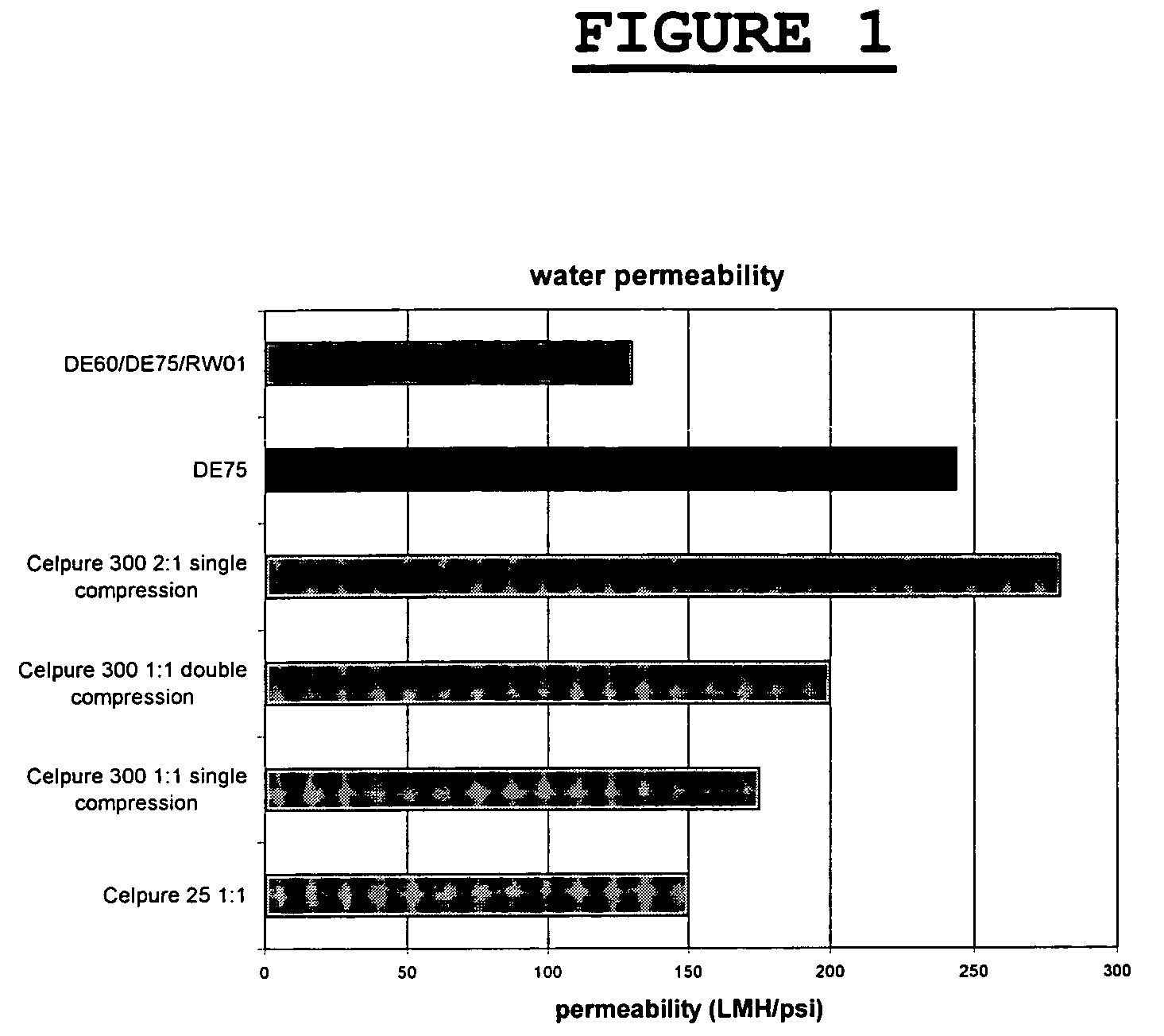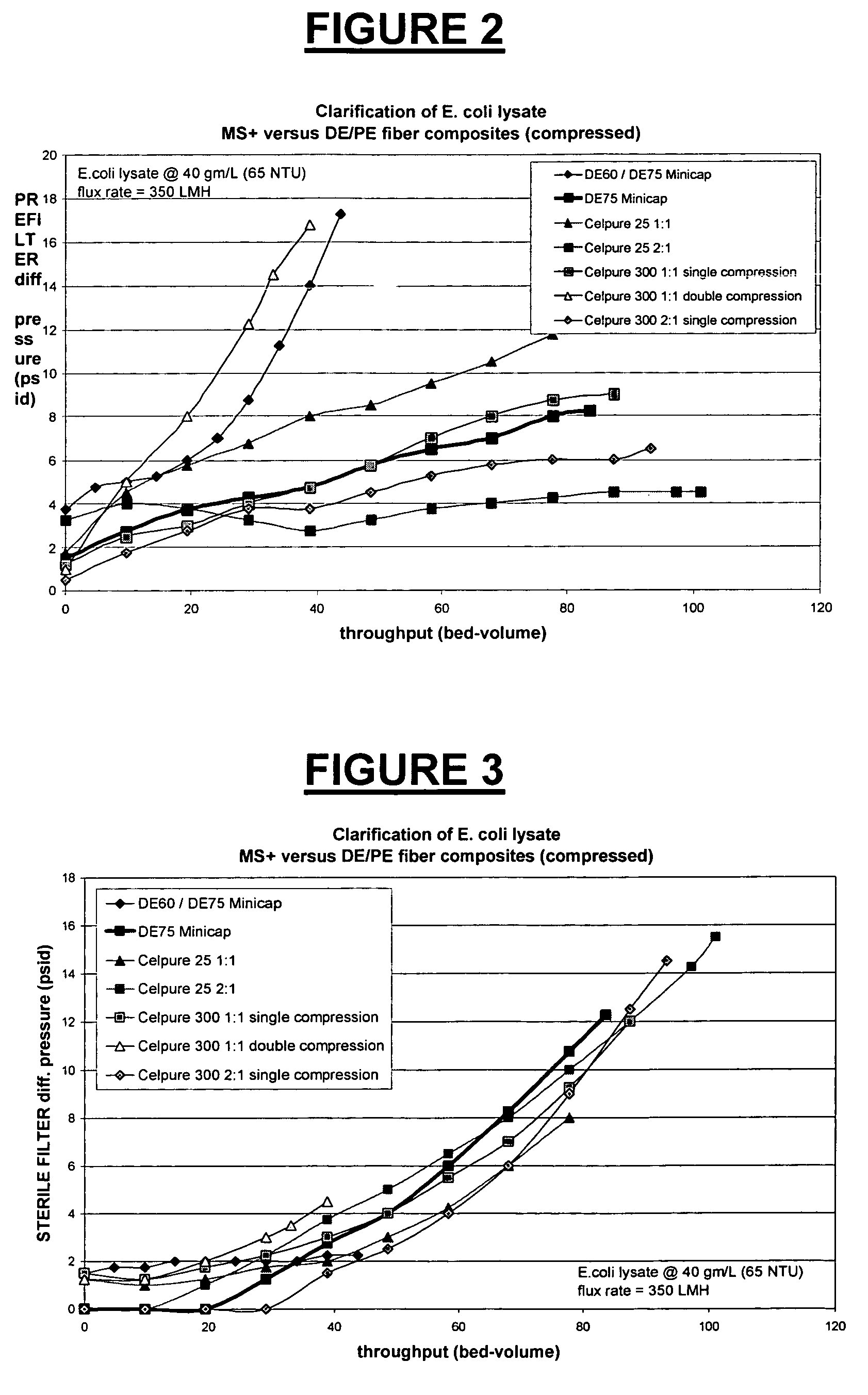Adsorbent filter media for removal of biological contaminants in process liquids
a technology of filter media and biological contaminants, which is applied in the direction of filtration separation, other chemical processes, separation processes, etc., can solve the problems of releasing a relative high level of water-soluble contaminants into the system, and the maximum loading of diatomaceous earth adsorbent within the depth filter media is limited to about 60%, so as to reduce the contamination of the process liquid, reduce the amount of adsorbent, and reduce the effect of extraneous contaminants
- Summary
- Abstract
- Description
- Claims
- Application Information
AI Technical Summary
Benefits of technology
Problems solved by technology
Method used
Image
Examples
example 1
[0027]Samples of various blends of diatomaceous earth and polyethylene microfibers fused into pads of approximately 2-4 mm in thickness were tested in a standard clarification process step related to protein product recovery from mammalian cell cultures. The test was to challenge the adsorbent media with a suspension of E. coli lysate (in buffer) under constant flow conditions while monitoring the pressure rise on the media sample (rate of plugging) as well as the quality of the effluent relative to the volume of fluid processed. Effluent or filtrate quality was measured by directly filtering the fluid through a 0.2 micron sterilizing grade membrane filter, in this case Durapore® GV. These experimental composite samples were again compared to Millistak®+ cellulosic depth filter media.
[0028]FIGS. 2 and 3 show the pressure profiles for the adsorbent media samples and Millistak®+ pads and the associated sterile filter profiles. Throughput is reported as the volume of fluid processed re...
example 2
[0030]Samples of diatomaceous earth fused into a fixed-bed pad using polyethylene powder (Mipelon™, Mitsui Chemical) were tested for their capacity to protect a viral retentive membrane, NFP Viresolve 180. In this test, the DE / PE composite (approximately 3 mm thick) was challenged with a solution of polyclonal human IgG protein at a concentration of 0.5 gm / L. The Viresolve® membrane typically yields a capacity of approximately 150 L / m2 for this feedstock. Using the Millistak®+ A1HC depth filter to pre-treat this feedstock for the removal of protein agglomerates, the Viresolve membrane capacity can be increased to the range of 750-1500 L / m2. Two samples of diatomaceous earth (Celpure 25 and Celpure 300 (Advanced Minerals)) were blended with the Mipelon PE powder and formed into 2-3 mm pads after heating (without compression). The DE / PE composite samples were then used to pre-treat the IgG feedstock and the filtrate was again processed through Viresolve 180 to determine the effect on ...
example 3
[0032]To gauge the cleanliness of the composite materials of the invention, material samples were flushed with clean deionized water and the conductivity of the effluent, after a prescribed flush volume, was measured. Conductivity values were taken to represent the level of soluble metals present in the filter media. FIG. 4 shows the conductivity values obtained for various DE / PE composite samples relative to commercial Millistak®+ depth filter samples.
[0033]The Millistak®+ DE media is a composite of cellulose and diatomaceous earth plus a water-soluble thermoset resin binder. The CE media contains only cellulose fiber and binder. It is evident from these measurements that those extractibles that contribute to conductivity (inorganics) do not derive predominantly from the diatomaceous earth. Comparing these values to the DE / PE composites tested, there is reduction in effluent conductivity of 75-90%.
PUM
| Property | Measurement | Unit |
|---|---|---|
| thickness | aaaaa | aaaaa |
| bead diameter | aaaaa | aaaaa |
| particle size | aaaaa | aaaaa |
Abstract
Description
Claims
Application Information
 Login to View More
Login to View More - R&D
- Intellectual Property
- Life Sciences
- Materials
- Tech Scout
- Unparalleled Data Quality
- Higher Quality Content
- 60% Fewer Hallucinations
Browse by: Latest US Patents, China's latest patents, Technical Efficacy Thesaurus, Application Domain, Technology Topic, Popular Technical Reports.
© 2025 PatSnap. All rights reserved.Legal|Privacy policy|Modern Slavery Act Transparency Statement|Sitemap|About US| Contact US: help@patsnap.com



